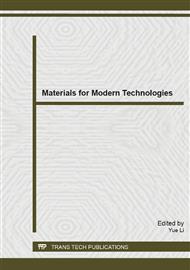[1]
K. Wakino, T. Nishikawa, Y. Ishikawa, et al., Dielectric resonator materials and their applications for mobile communication systems, British ceramic. Transactions and journal. 89(1990)39-43.
Google Scholar
[2]
J.A. Lee, J.H. Lee, J.J. Kim, Low-temperature sintering and microwave dielectric characteristics of Ba2Ti9O20 ceramics, Journal of the European Ceramic Society. 26(2006)2111-2115.
DOI: 10.1016/j.jeurceramsoc.2005.09.066
Google Scholar
[3]
T. Takada, S.F. Wang, S. Yoshikawa, et al., Effect of glass additions on BaO-TiO2-WO3 microwave ceramics, Journal of the American Ceramic Society. 77(1994)1909-(1916).
DOI: 10.1111/j.1151-2916.1994.tb07070.x
Google Scholar
[4]
D. Liu, Y. Liu, S.Q. Huang, et al., Phase structure and dielectric properties of Bi2O3–ZnO– Nb2O5 based dielectric ceramics, Journal of the American Ceramic Society. 76(1993)2129-2132.
DOI: 10.1111/j.1151-2916.1993.tb08348.x
Google Scholar
[5]
M. Valant, P.K. Davies. Synthesis and dielectric properties of pyrochlore solid solutions in the Bi2O3–ZnO–Nb2O5–TiO2 system, Journal of Material Science. 34(1999)5437-5442.
Google Scholar
[6]
M. Valant, P.K. Davies, Crystal chemistry and dielectric properties of chemically substituted (Bi1. 5Zn1. 0Nb1. 5)O7 and Bi2(Zn2/3Nb4/3)O7 pyrochlores, Journal of the American Ceramic Society. 83(2000)147-153.
DOI: 10.1063/1.4947997
Google Scholar
[7]
DA Silva, S. A, ZANETTI, et al., Processing of Bi1. 5ZnNb1. 5O7 ceramics for LTCC applica- tions: comparison of synthesis and sintering methods, Ceramics International. 35 (2009)2755-2759.
DOI: 10.1016/j.ceramint.2009.03.022
Google Scholar
[8]
H.F. Zhou, J.L. Huang, R.U. Wang, et al., Effect of Bi4Ti3O12 addition on microstructure and dielectric properties of (Bi1. 5Zn0. 5)(Zn0. 5Nb1. 5)O7 ceramic, Journal of Functional Materials. 36(2005)1204-1206.
Google Scholar
[9]
H.F. Zhou, J.L. Huang, R.U. Wang, et al., Effect of BiVO4 doping on dielectric properties of (Bi1. 5Zn0. 5)(Zn0. 5Nb1. 5)O7 ceramics, Journal of the Chinese Ceramic Society. 33(2005)1453-1456.
Google Scholar
[10]
R.U. Wang, J.L. Huang, H.F. Zhou, et al., Effect of V2O5 additives on properties of (Bi1. 5Zn1. 0Nb1. 5)O7 dielectric ceramics, Bulletin of the Chinese Ceramic Society. 24(2005)116-119.
Google Scholar
[11]
M.C. WU, C.W. Hsieh, C.W. Yen, et al., Low sintering BaNd2Ti4O12 microwave ceramics prepared by CuO thin layer coated powder, Journal of the European Ceramic Society. 27 (2007)2835–2839.
DOI: 10.1016/j.jeurceramsoc.2006.11.057
Google Scholar
[12]
W.S. Kim, T.H. Kim, E.S. Kim, et al., Microwave dielectric properties and far infrared reflectivity spectra of the (Zr0. 8Sn0. 2)TiO4 ceramic with additives, Japanese Journal of Applied Physics. 37(1998)5367-5371.
DOI: 10.1143/jjap.37.5367
Google Scholar


